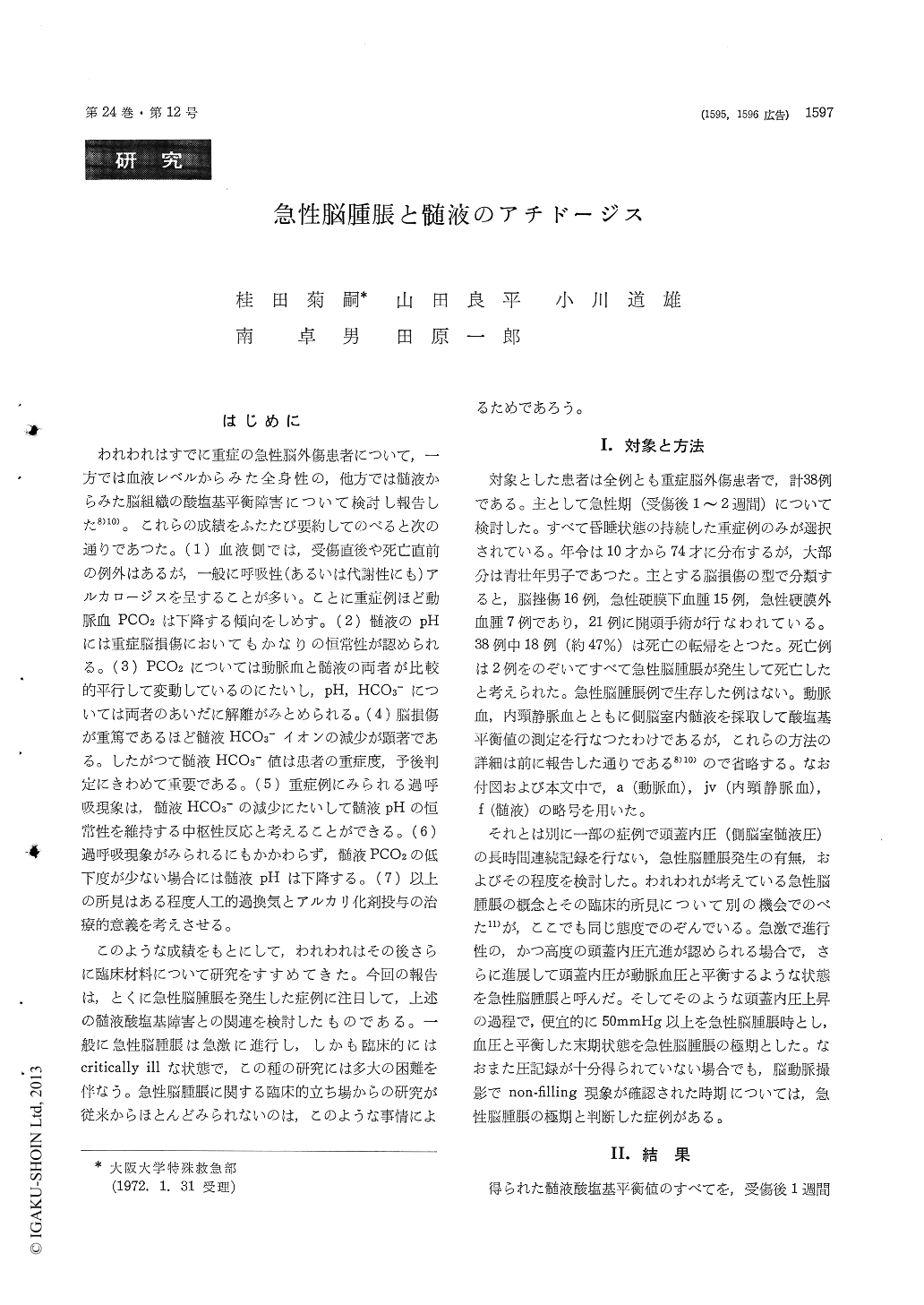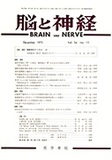Japanese
English
- 有料閲覧
- Abstract 文献概要
- 1ページ目 Look Inside
はじめに
われわれはすでに重症の急性脳外傷患者について,一方では血液レベルからみた全身性の,他方では髄液からみた脳組織の酸塩基平衡障害について検討し報告した8)10)。これらの成績をふたたび要約してのべると次の通りであつた。(1)血液側では,受傷直後や死亡直前の例外はあるが,一般に呼吸性(あるいは代謝性にも)アルカロージスを呈することが多い。ことに重症例ほど動脈血PCO2は下降する傾向をしめす。(2)髄液のpHには重症脳損傷においてもかなりの恒常性が認められる。(3) PCO2については動脈血と髄液の両者が比較的平行して変動しているのにたいし,pH,HCO3−については両者のあいだに解離がみとめられる。(4)脳損傷が重篤であるほど髄液HCO3−イオンの減少が顕著である。したがつて髄液HCO3−値は患者の重症度,予後判定にきわめて重要である。(5)重症例にみられる過呼吸現象は,髄液HCO3−の減少にたいして髄液pHの恒常性を維持する中枢性反応と考えることができる。(6)過呼吸現象がみられるにもかかわらず,髄液PCO2の低下度が少ない場合には髄液pHは下降する。(7)以上の所見はある程度人工的過換気とアルカリ化剤投与の治療的意義を考えさせる。
このような成績をもとにして,われわれはその後さらに臨床材料について研究をすすめてきた。今回の報告は,とくに急性脳腫脹を発生した症例に注目して,上述の髄液酸塩基障害との関連を検討したものである。一般に急性脳腫脹は急激に進行し,しかも臨床的にはcritically illな状態で,この種の研究には多大の困難を伴なう。急性脳腫脹に関する臨床的立ち場からの研究が従来からほとんどみられないのは,このような事情によるためであろう。
In 38 patients who had been suffering from acute, severe head injury, the acid-base status of cerebro-spinal fluid (CSF), arterial blood (A) and internal jugular venous blood (JV) were investigated. The intraventricular CSF pressure was also monitored on them. In 17 patients, the intraventricular pres-sure showed rapid and progressive rise and ultimate-ly equalled to the mean arterial pressure. This state was regarded as acute brain swelling. The special attention was directed to the relation bet-ween CSF acidosis and the progress of acute brain swelling.
As reported previously, the decrease of CSF HCO3- ion concentration was of common finding in the early period after severe cerebral trauma. But at the stage of acute brain swelling, the re-markable fall of CSF PH was observed invariably, in addition to decreased CSF HCO3-. There was an evidence at that time that the decrease of CSF PCO2 was not sufficient to retain normal CSF PH. As the acute brain swelling advanced, CSF PCO2 climbed to extremely high level, mostly above 80 mmHg. The abnormal acid-base status of CSF above mentioned was independent on that of arter-ial blood.
The acute brain swelling was always preceded by the extreme and sustained fall of CSF HCO3-. That was, especially when associated with minimal decrease of PCO2, the sign of the subsequent acute brain swelling in most cases. In addition, it was noticeable that both the CSF-A and CSF-JV PCO2 difference were widened in this situation. These data might indicate that the elimination of brain tissue CO2 was impaired by CSF-blood block and by the cessation of cerebral venous return as well. CSF PCO2 should be estimated not as a respiratory factor but as a cerebral circulatory one. It was true that the phenomenon of so-called neurogenic hyper-ventilation was a homeostatic reaction to keep normalPH of CSF. But the phenomenon was seen to a larger extent in the patients who showed CSF-A PCO2 difference of wider value.
From the data obtained from the present study, the therapeutic value of intravenous administration of bicarbonate or THAM solution and artificial hyperventilation should be suggested. Our feelingwas that the significant effects of them could not be expected on the brain tissue level, since the interstitial edema and the circulatory disturbance might interfere with it. The indication and the method to correct the disturbance of CSF acid-base balance were discussed.

Copyright © 1972, Igaku-Shoin Ltd. All rights reserved.


